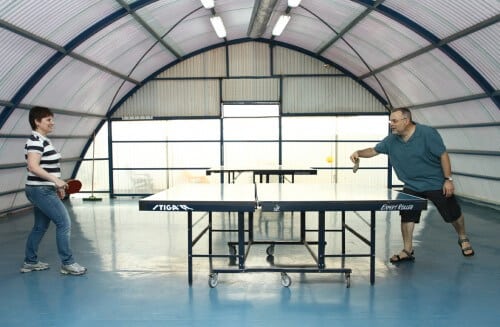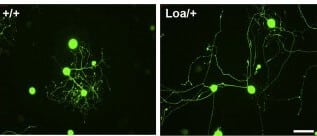How do cells measure their size? This question is of particular significance when it comes to a large cell, such as a nerve cell in the peripheral nervous system, which creates extensions - axons - which can reach up to one meter in length in humans, 20,000 times the width of an average cell

How do cells measure their size? This question is of particular significance when it comes to a large cell, such as a nerve cell in the peripheral nervous system, which creates extensions - axons - whose length can reach up to one meter in humans, 20,000 times the width of an average cell. The developing branch needs a constant supply of building materials. Without basic information about the distance to be covered, transporting the materials to the end of the extension could turn into a logistical nightmare, causing traffic jams in the supply lines. It is likely that such long cells measure their size continuously to manage the growth process, but until now scientists did not know exactly how they do this.
Dr. Ida Rischel and Prof. Mike Feinzylver from the Department of Biological Chemistry at the institute, together with their colleagues, recently provided the answer for large cells - such as nerve cells. These findings may also advance our ability to speed up the recovery of damaged nerve cells.
Prof. Fainzilber and Dr. Rischel, together with Dr. Naaman Kam and Rotem Ben-Tov Perry from the Department of Biological Chemistry, Dr. Vera Shinder from the Department of Chemical Research Infrastructures, Prof. Elizabeth Fisher from University College London, and Prof. Giampietro Schiavo from the Institute For cancer research in London, they believed that the solution to the question may lie in the "transportation system" which crosses the nerve cell along its entire length, and carries signals and charges along the cell. The system includes a "rail" made of tiny tubules, and two types of motors that move along it: one type, kinesin, moves exclusively from the center of the cell to the end of the axon, while the other type, dynein, moves in the opposite direction, from the end of the axon to the center of the cell. Does the cell use the signals carried on these motors to measure its length?

In the first step, the scientists created computer models, which describe possible mechanisms by which the cellular motors may measure the distance they travel. According to one model, the dynein motors, moving towards the center of the cell, gradually release signals like scattering breadcrumbs along the path at fixed distances. The amount of signals left in their possession at the end of the route will make it possible to find out the distance they have traveled. According to this model, reducing the number of dynein motors will lead to a decrease in the number of signals remaining at the end of the pathway, therefore causing an overestimation of cell length. As a result, the growth rate of the branches will slow down, and at the end of the growth process they will be shorter.
The second model is based on a feedback loop between the two types of engines. When the signal sent from one of the engines reaches the end of the line, it activates another signal that is sent back by the other engine, delaying the delivery of the original signal upon its arrival, and God forbid. In this case, the length measurement is based on timing, or, more precisely, on the frequency of signal reception at the end points. You can simulate the mechanism for a ping-pong game: when playing on a small area, close to the net, the hits will be faster. Conversely, playing from the edges of the table will lead to longer breaks between one racket stroke and another. Unlike the first model, in this case, a reduction in the amount of one of the motors will actually cause faster growth and the creation of longer extensions, because the frequency of the signals will decrease at a slower rate.
In the second stage, the scientists performed experiments, first in cell cultures and then in mice, in which they reduced the amount of dynein. In both cases, the extensions grew to a greater length than usual, thus negating the correctness of the first model, and strengthening the correctness of the second model.
In the last step, the scientists wanted to check if the mechanism is unique to nerve cells, or if perhaps other large cells use similar methods to measure their size, and repeated the experiment with connective tissue cells - called fibroblasts. In this case too, the scientists found evidence of the use of the same mechanism, based on the frequency of the signals.
The findings not only provide a possible explanation for a long-standing mystery - how large cells estimate their size, but they are also significant for research on nerve cell regeneration. Nerve cells belonging to the peripheral nervous system are indeed able to regrow after an injury, but this is a very slow process, and sometimes it takes years for them to return to their original size. Part of the reason for this is that once a nerve cell reaches its destination - which usually happens during embryonic development - it stops growing and elongating from the tip, and instead grows by stretching along its entire length. Understanding the exact signals that the cell uses not only to measure itself, but also to direct its growth accordingly, may point to new directions for accelerating the regeneration of nerve cells.
